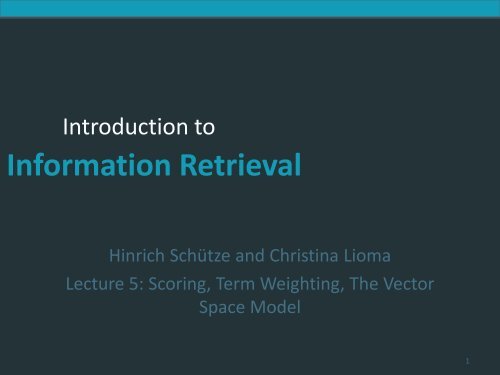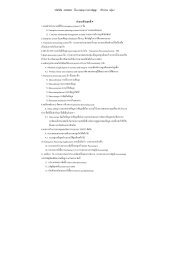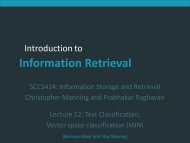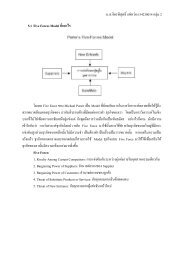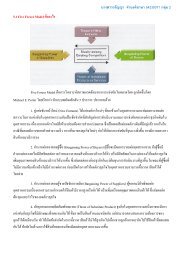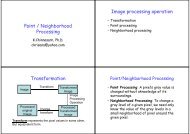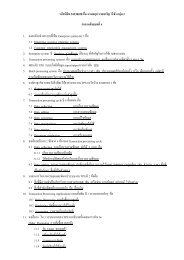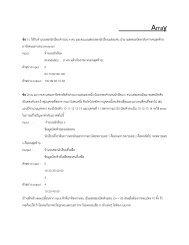Introduction to Information Retrieval
Introduction to Information Retrieval
Introduction to Information Retrieval
You also want an ePaper? Increase the reach of your titles
YUMPU automatically turns print PDFs into web optimized ePapers that Google loves.
<strong>Introduction</strong> <strong>to</strong> <strong>Information</strong> <strong>Retrieval</strong><br />
<strong>Introduction</strong> <strong>to</strong><br />
<strong>Information</strong> <strong>Retrieval</strong><br />
Hinrich Schütze and Christina Lioma<br />
Lecture 5: Scoring, Term Weighting, The Vec<strong>to</strong>r<br />
Space Model<br />
1
<strong>Introduction</strong> <strong>to</strong> <strong>Information</strong> <strong>Retrieval</strong><br />
Take-away <strong>to</strong>day<br />
• Ranking search results: why it is important (as opposed <strong>to</strong> just<br />
presenting a set of unordered Boolean results)<br />
• Term frequency: This is a key ingredient for ranking.<br />
• Tf-idf ranking: best known traditional ranking scheme<br />
• Vec<strong>to</strong>r space model: One of the most important formal<br />
models for information retrieval (along with Boolean and<br />
probabilistic models)<br />
2
<strong>Introduction</strong> <strong>to</strong> <strong>Information</strong> <strong>Retrieval</strong><br />
Outline<br />
❶ Take-away <strong>to</strong>day<br />
❷ Why ranked retrieval?<br />
❸ Term frequency<br />
❹ tf-idf weighting<br />
❺ The vec<strong>to</strong>r space model<br />
3
<strong>Introduction</strong> <strong>to</strong> <strong>Information</strong> <strong>Retrieval</strong><br />
Ranked retrieval<br />
• Thus far, our queries have all been Boolean.<br />
• Documents either match or don’t.<br />
• Good for expert users with precise understanding of their<br />
needs and of the collection.<br />
• Also good for applications: Applications can easily consum<br />
1000s of results.<br />
• Not good for the majority of users<br />
• Most users are not capable of writing Boolean queries . . .<br />
• . . . or they are, but they think it’s <strong>to</strong>o much work.<br />
• Most users don’t want <strong>to</strong> wade through 1000s of results.<br />
• This is particularly true of web search.<br />
4
<strong>Introduction</strong> <strong>to</strong> <strong>Information</strong> <strong>Retrieval</strong><br />
Problem with Boolean search: Feast or famine<br />
• Boolean queries often result in either <strong>to</strong>o few (=0) or <strong>to</strong>o<br />
many (1000s) results.<br />
• Query 1 (boolean conjunction): [standard user dlink 650]<br />
• → 200,000 hits – feast<br />
• Query 2 (boolean conjunction): [standard user dlink 650 no<br />
card found]<br />
• → 0 hits – famine<br />
• In Boolean retrieval, it takes a lot of skill <strong>to</strong> come up with a<br />
query that produces a manageable number of hits.<br />
5
<strong>Introduction</strong> <strong>to</strong> <strong>Information</strong> <strong>Retrieval</strong><br />
Feast or famine: No problem in ranked retrieval<br />
• With ranking, large result sets are not an issue.<br />
• Just show the <strong>to</strong>p 10 results<br />
• Doesn’t overwhelm the user<br />
• Premise: the ranking algorithm works: More relevant results<br />
are ranked higher than less relevant results.<br />
6
<strong>Introduction</strong> <strong>to</strong> <strong>Information</strong> <strong>Retrieval</strong><br />
Scoring as the basis of ranked retrieval<br />
• We wish <strong>to</strong> rank documents that are more relevant higher<br />
than documents that are less relevant.<br />
• How can we accomplish such a ranking of the documents in<br />
the collection with respect <strong>to</strong> a query?<br />
• Assign a score <strong>to</strong> each query-document pair, say in [0, 1].<br />
• This score measures how well document and query “match”.<br />
7
<strong>Introduction</strong> <strong>to</strong> <strong>Information</strong> <strong>Retrieval</strong><br />
Query-document matching scores<br />
• How do we compute the score of a query-document pair?<br />
• Let’s start with a one-term query.<br />
• If the query term does not occur in the document: score<br />
should be 0.<br />
• The more frequent the query term in the document, the<br />
higher the score<br />
• We will look at a number of alternatives for doing this.<br />
8
<strong>Introduction</strong> <strong>to</strong> <strong>Information</strong> <strong>Retrieval</strong><br />
Take 1: Jaccard coefficient<br />
• A commonly used measure of overlap of two sets<br />
• Let A and B be two sets<br />
• Jaccard coefficient:<br />
• JACCARD (A, A) = 1<br />
• JACCARD (A, B) = 0 if A ∩ B = 0<br />
• A and B don’t have <strong>to</strong> be the same size.<br />
• Always assigns a number between 0 and 1.<br />
9
<strong>Introduction</strong> <strong>to</strong> <strong>Information</strong> <strong>Retrieval</strong><br />
Jaccard coefficient: Example<br />
• What is the query-document match score that the Jaccard<br />
coefficient computes for:<br />
• Query: “ides of March”<br />
• Document “Caesar died in March”<br />
• JACCARD(q, d) = 1/6<br />
10
<strong>Introduction</strong> <strong>to</strong> <strong>Information</strong> <strong>Retrieval</strong><br />
What’s wrong with Jaccard?<br />
• It doesn’t consider term frequency (how many occurrences a<br />
term has).<br />
• Rare terms are more informative than frequent terms.<br />
Jaccard does not consider this information.<br />
• We need a more sophisticated way of normalizing for the<br />
length of a document.<br />
• Later in this lecture, we’ll use (cosine) . . .<br />
• . . . instead of |A ∩ B|/|A ∪ B| (Jaccard) for length<br />
normalization.<br />
11
<strong>Introduction</strong> <strong>to</strong> <strong>Information</strong> <strong>Retrieval</strong><br />
Outline<br />
❶ Recap<br />
❷ Why ranked retrieval?<br />
❸ Term frequency<br />
❹ tf-idf weighting<br />
❺ The vec<strong>to</strong>r space model<br />
12
<strong>Introduction</strong> <strong>to</strong> <strong>Information</strong> <strong>Retrieval</strong><br />
Binary incidence matrix<br />
Anthony<br />
and<br />
Cleopatra<br />
Julius<br />
Caesar<br />
The<br />
Tempest<br />
Hamlet Othello Macbeth<br />
. . .<br />
ANTHONY<br />
BRUTUS<br />
CAESAR<br />
CALPURNIA<br />
CLEOPATRA<br />
MERCY<br />
WORSER<br />
. . .<br />
1<br />
1<br />
1<br />
0<br />
1<br />
1<br />
1<br />
1<br />
1<br />
1<br />
1<br />
0<br />
0<br />
0<br />
0<br />
0<br />
0<br />
0<br />
0<br />
1<br />
1<br />
0<br />
1<br />
1<br />
0<br />
0<br />
1<br />
1<br />
0<br />
0<br />
1<br />
0<br />
0<br />
1<br />
1<br />
1<br />
0<br />
1<br />
0<br />
0<br />
1<br />
0<br />
Each document is represented as a binary vec<strong>to</strong>r ∈ {0, 1} |V|. 13<br />
13
<strong>Introduction</strong> <strong>to</strong> <strong>Information</strong> <strong>Retrieval</strong><br />
Binary incidence matrix<br />
Anthony<br />
and<br />
Cleopatra<br />
Julius<br />
Caesar<br />
The<br />
Tempest<br />
Hamlet Othello Macbeth<br />
. . .<br />
ANTHONY<br />
BRUTUS<br />
CAESAR<br />
CALPURNIA<br />
CLEOPATRA<br />
MERCY<br />
WORSER<br />
. . .<br />
157<br />
4<br />
232<br />
0<br />
57<br />
2<br />
2<br />
73<br />
157<br />
227<br />
10<br />
0<br />
0<br />
0<br />
0<br />
0<br />
0<br />
0<br />
0<br />
3<br />
1<br />
0<br />
2<br />
2<br />
0<br />
0<br />
8<br />
1<br />
0<br />
0<br />
1<br />
0<br />
0<br />
5<br />
1<br />
1<br />
0<br />
0<br />
0<br />
0<br />
8<br />
5<br />
Each document is now represented as a count vec<strong>to</strong>r ∈ N |V|. 14<br />
14
<strong>Introduction</strong> <strong>to</strong> <strong>Information</strong> <strong>Retrieval</strong><br />
Bag of words model<br />
• We do not consider the order of words in a document.<br />
• John is quicker than Mary and Mary is quicker than John<br />
are represented the same way.<br />
• This is called a bag of words model.<br />
• In a sense, this is a step back: The positional index was able<br />
<strong>to</strong> distinguish these two documents.<br />
• We will look at “recovering” positional information later in<br />
this course.<br />
• For now: bag of words model<br />
15
<strong>Introduction</strong> <strong>to</strong> <strong>Information</strong> <strong>Retrieval</strong><br />
Term frequency tf<br />
• The term frequency tf t,d of term t in document d is defined<br />
as the number of times that t occurs in d.<br />
• We want <strong>to</strong> use tf when computing query-document match<br />
scores.<br />
• But how?<br />
• Raw term frequency is not what we want because:<br />
• A document with tf = 10 occurrences of the term is more<br />
relevant than a document with tf = 1 occurrence of the<br />
term.<br />
• But not 10 times more relevant.<br />
• Relevance does not increase proportionally with term<br />
frequency.<br />
16
<strong>Introduction</strong> <strong>to</strong> <strong>Information</strong> <strong>Retrieval</strong><br />
Instead of raw frequency: Log frequency<br />
weighting<br />
• The log frequency weight of term t in d is defined as follows<br />
• tf t,d → w t,d :<br />
0 → 0, 1 → 1, 2 → 1.3, 10 → 2, 1000 → 4, etc.<br />
• Score for a document-query pair: sum over terms t in both q<br />
and d:<br />
tf-matching-score(q, d) = t∈q∩d (1 + log tf t,d )<br />
<br />
• The score is 0 if none of the query terms is present in the<br />
document.<br />
17
<strong>Introduction</strong> <strong>to</strong> <strong>Information</strong> <strong>Retrieval</strong><br />
Outline<br />
❶ Recap<br />
❷ Why ranked retrieval?<br />
❸ Term frequency<br />
❹ tf-idf weighting<br />
❺ The vec<strong>to</strong>r space model<br />
18
<strong>Introduction</strong> <strong>to</strong> <strong>Information</strong> <strong>Retrieval</strong><br />
Frequency in document vs. frequency in<br />
collection<br />
• In addition, <strong>to</strong> term frequency (the frequency of the term<br />
in the document) . . .<br />
• . . .we also want <strong>to</strong> use the frequency of the term in the<br />
collection for weighting and ranking.<br />
19
<strong>Introduction</strong> <strong>to</strong> <strong>Information</strong> <strong>Retrieval</strong><br />
Desired weight for rare terms<br />
• Rare terms are more informative than frequent terms.<br />
• Consider a term in the query that is rare in the collection<br />
(e.g., ARACHNOCENTRIC).<br />
• A document containing this term is very likely <strong>to</strong> be<br />
relevant.<br />
• → We want high weights for rare terms like<br />
ARACHNOCENTRIC.<br />
20
<strong>Introduction</strong> <strong>to</strong> <strong>Information</strong> <strong>Retrieval</strong><br />
Desired weight for frequent terms<br />
• Frequent terms are less informative than rare terms.<br />
• Consider a term in the query that is frequent in the<br />
collection (e.g., GOOD, INCREASE, LINE).<br />
• A document containing this term is more likely <strong>to</strong> be<br />
relevant than a document that doesn’t . . .<br />
• . . . but words like GOOD, INCREASE and LINE are not sure<br />
indica<strong>to</strong>rs of relevance.<br />
• → For frequent terms like GOOD, INCREASE and LINE, we<br />
want positive weights . . .<br />
• . . . but lower weights than for rare terms.<br />
21
<strong>Introduction</strong> <strong>to</strong> <strong>Information</strong> <strong>Retrieval</strong><br />
Document frequency<br />
• We want high weights for rare terms like ARACHNOCENTRIC.<br />
• We want low (positive) weights for frequent words like<br />
GOOD, INCREASE and LINE.<br />
• We will use document frequency <strong>to</strong> fac<strong>to</strong>r this in<strong>to</strong><br />
computing the matching score.<br />
• The document frequency is the number of documents in<br />
the collection that the term occurs in.<br />
22
<strong>Introduction</strong> <strong>to</strong> <strong>Information</strong> <strong>Retrieval</strong><br />
idf weight<br />
• df t is the document frequency, the number of documents<br />
that t occurs in.<br />
• df t is an inverse measure of the informativeness of term t.<br />
• We define the idf weight of term t as follows:<br />
(N is the number of documents in the collection.)<br />
• idf t is a measure of the informativeness of the term.<br />
• [log N/df t ] instead of [N/df t ] <strong>to</strong> “dampen” the effect of idf<br />
• Note that we use the log transformation for both term<br />
frequency and document frequency.<br />
23
<strong>Introduction</strong> <strong>to</strong> <strong>Information</strong> <strong>Retrieval</strong><br />
Examples for idf<br />
• Compute idf t using the formula:<br />
term df t idf t<br />
calpurnia<br />
animal<br />
sunday<br />
fly<br />
under<br />
the<br />
1<br />
100<br />
1000<br />
10,000<br />
100,000<br />
1,000,000<br />
6<br />
4<br />
3<br />
2<br />
1<br />
0<br />
24
<strong>Introduction</strong> <strong>to</strong> <strong>Information</strong> <strong>Retrieval</strong><br />
Effect of idf on ranking<br />
• idf affects the ranking of documents for queries with at<br />
least two terms.<br />
• For example, in the query “arachnocentric line”, idf<br />
weighting increases the relative weight of ARACHNOCENTRIC<br />
and decreases the relative weight of LINE.<br />
• idf has little effect on ranking for one-term queries.<br />
25
<strong>Introduction</strong> <strong>to</strong> <strong>Information</strong> <strong>Retrieval</strong><br />
Collection frequency vs. Document frequency<br />
word collection frequency document frequency<br />
INSURANCE<br />
TRY<br />
• Collection frequency of t: number of <strong>to</strong>kens of t in the<br />
collection<br />
• Document frequency of t: number of documents t occurs in<br />
• Why these numbers?<br />
10440<br />
10422<br />
• Which word is a better search term (and should get a<br />
higher weight)?<br />
• This example suggests that df (and idf) is better for<br />
weighting than cf (and “icf”).<br />
3997<br />
8760<br />
26
<strong>Introduction</strong> <strong>to</strong> <strong>Information</strong> <strong>Retrieval</strong><br />
tf-idf weighting<br />
• The tf-idf weight of a term is the product of its tf weight<br />
and its idf weight.<br />
• tf-weight<br />
• idf-weight<br />
• Best known weighting scheme in information retrieval<br />
• Note: the “-” in tf-idf is a hyphen, not a minus sign!<br />
• Alternative names: tf.idf, tf x idf<br />
27
<strong>Introduction</strong> <strong>to</strong> <strong>Information</strong> <strong>Retrieval</strong><br />
Summary: tf-idf<br />
• Assign a tf-idf weight for each term t in each document d:<br />
• The tf-idf weight . . .<br />
• . . . increases with the number of occurrences within a<br />
document. (term frequency)<br />
• . . . increases with the rarity of the term in the collection.<br />
(inverse document frequency)<br />
28
<strong>Introduction</strong> <strong>to</strong> <strong>Information</strong> <strong>Retrieval</strong><br />
Exercise: Term, collection and document<br />
frequency<br />
Quantity<br />
term frequency<br />
document frequency<br />
collection frequency<br />
Symbol Definition<br />
tf t,d<br />
df t<br />
cf t<br />
number of occurrences of t in<br />
d<br />
number of documents in the<br />
collection that t occurs in<br />
<strong>to</strong>tal number of occurrences of<br />
t in the collection<br />
• Relationship between df and cf?<br />
• Relationship between tf and cf?<br />
• Relationship between tf and df?<br />
29
<strong>Introduction</strong> <strong>to</strong> <strong>Information</strong> <strong>Retrieval</strong><br />
Outline<br />
❶ Recap<br />
❷ Why ranked retrieval?<br />
❸ Term frequency<br />
❹ tf-idf weighting<br />
❺ The vec<strong>to</strong>r space model<br />
30
<strong>Introduction</strong> <strong>to</strong> <strong>Information</strong> <strong>Retrieval</strong><br />
Binary incidence matrix<br />
Anthony<br />
and<br />
Cleopatra<br />
Julius<br />
Caesar<br />
The<br />
Tempest<br />
Hamlet Othello Macbeth<br />
. . .<br />
ANTHONY<br />
BRUTUS<br />
CAESAR<br />
CALPURNIA<br />
CLEOPATRA<br />
MERCY<br />
WORSER<br />
. . .<br />
1<br />
1<br />
1<br />
0<br />
1<br />
1<br />
1<br />
1<br />
1<br />
1<br />
1<br />
0<br />
0<br />
0<br />
0<br />
0<br />
0<br />
0<br />
0<br />
1<br />
1<br />
0<br />
1<br />
1<br />
0<br />
0<br />
1<br />
1<br />
0<br />
0<br />
1<br />
0<br />
0<br />
1<br />
1<br />
1<br />
0<br />
1<br />
0<br />
0<br />
1<br />
0<br />
Each document is represented as a binary vec<strong>to</strong>r ∈ {0, 1} |V|. 31<br />
31
<strong>Introduction</strong> <strong>to</strong> <strong>Information</strong> <strong>Retrieval</strong><br />
Count matrix<br />
Anthony<br />
and<br />
Cleopatra<br />
Julius<br />
Caesar<br />
The<br />
Tempest<br />
Hamlet Othello Macbeth<br />
. . .<br />
ANTHONY<br />
BRUTUS<br />
CAESAR<br />
CALPURNIA<br />
CLEOPATRA<br />
MERCY<br />
WORSER<br />
. . .<br />
157<br />
4<br />
232<br />
0<br />
57<br />
2<br />
2<br />
73<br />
157<br />
227<br />
10<br />
0<br />
0<br />
0<br />
0<br />
0<br />
0<br />
0<br />
0<br />
3<br />
1<br />
0<br />
2<br />
2<br />
0<br />
0<br />
8<br />
1<br />
0<br />
0<br />
1<br />
0<br />
0<br />
5<br />
1<br />
1<br />
0<br />
0<br />
0<br />
0<br />
8<br />
5<br />
Each document is now represented as a count vec<strong>to</strong>r ∈ N |V|. 32<br />
32
<strong>Introduction</strong> <strong>to</strong> <strong>Information</strong> <strong>Retrieval</strong><br />
Binary → count → weight matrix<br />
Anthony<br />
and<br />
Cleopatra<br />
Julius<br />
Caesar<br />
The<br />
Tempest<br />
Hamlet Othello Macbeth<br />
. . .<br />
ANTHONY<br />
BRUTUS<br />
CAESAR<br />
CALPURNIA<br />
CLEOPATRA<br />
MERCY<br />
WORSER<br />
. . .<br />
5.25<br />
1.21<br />
8.59<br />
0.0<br />
2.85<br />
1.51<br />
1.37<br />
3.18<br />
6.10<br />
2.54<br />
1.54<br />
0.0<br />
0.0<br />
0.0<br />
0.0<br />
0.0<br />
0.0<br />
0.0<br />
0.0<br />
1.90<br />
0.11<br />
0.0<br />
1.0<br />
1.51<br />
0.0<br />
0.0<br />
0.12<br />
4.15<br />
0.0<br />
0.0<br />
0.25<br />
0.0<br />
0.0<br />
5.25<br />
0.25<br />
0.35<br />
0.0<br />
0.0<br />
0.0<br />
0.0<br />
0.88<br />
1.95<br />
Each document is now represented as a real-valued vec<strong>to</strong>r of tf<br />
idf weights ∈ R |V|. 33<br />
33
<strong>Introduction</strong> <strong>to</strong> <strong>Information</strong> <strong>Retrieval</strong><br />
Documents as vec<strong>to</strong>rs<br />
• Each document is now represented as a real-valued vec<strong>to</strong>r<br />
of tf-idf weights ∈ R |V|.<br />
• So we have a |V|-dimensional real-valued vec<strong>to</strong>r space.<br />
• Terms are axes of the space.<br />
• Documents are points or vec<strong>to</strong>rs in this space.<br />
• Very high-dimensional: tens of millions of dimensions when<br />
you apply this <strong>to</strong> web search engines<br />
• Each vec<strong>to</strong>r is very sparse - most entries are zero.<br />
34
<strong>Introduction</strong> <strong>to</strong> <strong>Information</strong> <strong>Retrieval</strong><br />
Queries as vec<strong>to</strong>rs<br />
• Key idea 1: do the same for queries: represent them as<br />
vec<strong>to</strong>rs in the high-dimensional space<br />
• Key idea 2: Rank documents according <strong>to</strong> their proximity <strong>to</strong><br />
the query<br />
• proximity = similarity<br />
• proximity ≈ negative distance<br />
• Recall: We’re doing this because we want <strong>to</strong> get away from<br />
the you’re-either-in-or-out, feast-or-famine Boolean<br />
model.<br />
• Instead: rank relevant documents higher than nonrelevant<br />
documents<br />
35
<strong>Introduction</strong> <strong>to</strong> <strong>Information</strong> <strong>Retrieval</strong><br />
How do we formalize vec<strong>to</strong>r space similarity?<br />
• First cut: (negative) distance between two points<br />
• ( = distance between the end points of the two vec<strong>to</strong>rs)<br />
• Euclidean distance?<br />
• Euclidean distance is a bad idea . . .<br />
• . . . because Euclidean distance is large for vec<strong>to</strong>rs of<br />
different lengths.<br />
36
<strong>Introduction</strong> <strong>to</strong> <strong>Information</strong> <strong>Retrieval</strong><br />
Why distance is a bad idea<br />
The Euclidean distance of and is large although the distribution<br />
of terms in the query q<br />
and the distribution of terms in the document d 2 are very similar.<br />
Questions about basic vec<strong>to</strong>r space setup?<br />
37
<strong>Introduction</strong> <strong>to</strong> <strong>Information</strong> <strong>Retrieval</strong><br />
Use angle instead of distance<br />
• Rank documents according <strong>to</strong> angle with query<br />
• Thought experiment: take a document d and append it <strong>to</strong><br />
itself. Call this document d′. d′ is twice as long as d.<br />
• “Semantically” d and d′ have the same content.<br />
• The angle between the two documents is 0, corresponding<br />
<strong>to</strong> maximal similarity . . .<br />
• . . . even though the Euclidean distance between the two<br />
documents can be quite large.<br />
38
<strong>Introduction</strong> <strong>to</strong> <strong>Information</strong> <strong>Retrieval</strong><br />
From angles <strong>to</strong> cosines<br />
• The following two notions are equivalent.<br />
• Rank documents according <strong>to</strong> the angle between query and<br />
document in decreasing order<br />
• Rank documents according <strong>to</strong> cosine(query,document) in<br />
increasing order<br />
• Cosine is a mono<strong>to</strong>nically decreasing function of the angle<br />
for the interval [0 ◦ , 180 ◦ ]<br />
39
<strong>Introduction</strong> <strong>to</strong> <strong>Information</strong> <strong>Retrieval</strong><br />
Cosine<br />
40
<strong>Introduction</strong> <strong>to</strong> <strong>Information</strong> <strong>Retrieval</strong><br />
Length normalization<br />
• How do we compute the cosine?<br />
• A vec<strong>to</strong>r can be (length-) normalized by dividing each of its<br />
components by its length – here we use the L 2 norm:<br />
• This maps vec<strong>to</strong>rs on<strong>to</strong> the unit sphere<br />
• As a result, longer documents and shorter documents have<br />
weights of the same order of magnitude.<br />
• Effect on the two documents d and d′ (d appended <strong>to</strong> itself)<br />
from earlier slide: they have identical vec<strong>to</strong>rs after lengthnormalization.<br />
41
<strong>Introduction</strong> <strong>to</strong> <strong>Information</strong> <strong>Retrieval</strong><br />
Cosine similarity between query and<br />
document<br />
• q i is the tf-idf weight of term i in the query.<br />
• d i is the tf-idf weight of term i in the document.<br />
• | | and | | are the lengths of<br />
and<br />
• This is the cosine similarity of and . . . . . . or,<br />
equivalently, the cosine of the angle between and<br />
42
<strong>Introduction</strong> <strong>to</strong> <strong>Information</strong> <strong>Retrieval</strong><br />
Cosine for normalized vec<strong>to</strong>rs<br />
• For normalized vec<strong>to</strong>rs, the cosine is equivalent <strong>to</strong> the dot<br />
product or scalar product.<br />
• (if and are length-normalized).<br />
43
<strong>Introduction</strong> <strong>to</strong> <strong>Information</strong> <strong>Retrieval</strong><br />
Cosine similarity illustrated<br />
44
<strong>Introduction</strong> <strong>to</strong> <strong>Information</strong> <strong>Retrieval</strong><br />
Cosine: Example<br />
term frequencies (counts)<br />
How similar are<br />
these novels?<br />
SaS: Sense and<br />
Sensibility<br />
PaP: Pride and<br />
Prejudice<br />
WH: Wuthering<br />
Heights<br />
term SaS PaP WH<br />
AFFECTION<br />
JEALOUS<br />
GOSSIP<br />
WUTHERING<br />
115<br />
10<br />
2<br />
0<br />
58<br />
7<br />
0<br />
0<br />
20<br />
11<br />
6<br />
38<br />
45
<strong>Introduction</strong> <strong>to</strong> <strong>Information</strong> <strong>Retrieval</strong><br />
Cosine: Example<br />
term frequencies (counts)<br />
log frequency weighting<br />
term<br />
AFFECTION<br />
JEALOUS<br />
GOSSIP<br />
WUTHERING<br />
SaS PaP WH<br />
115<br />
10<br />
2<br />
0<br />
58<br />
7<br />
0<br />
0<br />
20<br />
11<br />
6<br />
38<br />
term SaS PaP WH<br />
AFFECTION<br />
JEALOUS<br />
GOSSIP<br />
WUTHERING<br />
3.06<br />
2.0<br />
1.30<br />
0<br />
2.76<br />
1.85<br />
0<br />
0<br />
2.30<br />
2.04<br />
1.78<br />
2.58<br />
(To simplify this example, we don ' t do idf weighting.)<br />
46
<strong>Introduction</strong> <strong>to</strong> <strong>Information</strong> <strong>Retrieval</strong><br />
Cosine: Example<br />
log frequency weighting<br />
term SaS PaP WH<br />
AFFECTION<br />
JEALOUS<br />
GOSSIP<br />
WUTHERING<br />
3.06<br />
2.0<br />
1.30<br />
0<br />
2.76<br />
1.85<br />
0<br />
0<br />
2.30<br />
2.04<br />
1.78<br />
2.58<br />
log frequency weighting &<br />
cosine normalization<br />
term SaS PaP WH<br />
AFFECTION<br />
JEALOUS<br />
GOSSIP<br />
WUTHERING<br />
0.789<br />
0.515<br />
0.335<br />
0.0<br />
0.832<br />
0.555<br />
0.0<br />
0.0<br />
0.524<br />
0.465<br />
0.405<br />
0.588<br />
• cos(SaS,PaP) ≈<br />
0.789 ∗ 0.832 + 0.515 ∗ 0.555 + 0.335 ∗ 0.0 + 0.0 ∗ 0.0 ≈ 0.94.<br />
• cos(SaS,WH) ≈ 0.79<br />
• cos(PaP,WH) ≈ 0.69<br />
• Why do we have cos(SaS,PaP) > cos(SAS,WH)?<br />
47
<strong>Introduction</strong> <strong>to</strong> <strong>Information</strong> <strong>Retrieval</strong><br />
Computing the cosine score<br />
48
<strong>Introduction</strong> <strong>to</strong> <strong>Information</strong> <strong>Retrieval</strong><br />
Components of tf-idf weighting<br />
49
<strong>Introduction</strong> <strong>to</strong> <strong>Information</strong> <strong>Retrieval</strong><br />
tf-idf example<br />
• We often use different weightings for queries and documents.<br />
• Notation: ddd.qqq<br />
• Example: lnc.ltn<br />
• document: logarithmic tf, no df weighting, cosine<br />
normalization<br />
• query: logarithmic tf, idf, no normalization<br />
50
<strong>Introduction</strong> <strong>to</strong> <strong>Information</strong> <strong>Retrieval</strong><br />
Summary: Ranked retrieval in the vec<strong>to</strong>r space<br />
model<br />
• Represent the query as a weighted tf-idf vec<strong>to</strong>r<br />
• Represent each document as a weighted tf-idf vec<strong>to</strong>r<br />
• Compute the cosine similarity between the query vec<strong>to</strong>r and<br />
each document vec<strong>to</strong>r<br />
• Rank documents with respect <strong>to</strong> the query<br />
• Return the <strong>to</strong>p K (e.g., K = 10) <strong>to</strong> the user<br />
51
<strong>Introduction</strong> <strong>to</strong> <strong>Information</strong> <strong>Retrieval</strong><br />
Take-away <strong>to</strong>day<br />
• Ranking search results: why it is important (as opposed <strong>to</strong> just<br />
presenting a set of unordered Boolean results)<br />
• Term frequency: This is a key ingredient for ranking.<br />
• Tf-idf ranking: best known traditional ranking scheme<br />
• Vec<strong>to</strong>r space model: One of the most important formal<br />
models for information retrieval (along with Boolean and<br />
probabilistic models)<br />
52
<strong>Introduction</strong> <strong>to</strong> <strong>Information</strong> <strong>Retrieval</strong><br />
Resources<br />
• Chapters 6 and 7 of IIR<br />
• Resources at http://ifnlp.org/ir<br />
• Vec<strong>to</strong>r space for dummies<br />
• Exploring the similarity space (Moffat and Zobel, 2005)<br />
• Okapi BM25 (a state-of-the-art weighting method, 11.4.3 of IIR)<br />
53


